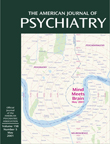Dr. Markovitz and Colleagues Reply
To the Editor: We are disappointed by the tone of Dr. Mendelson’s letter, but we are happy to have the opportunity to address his concerns. The issue of multiple tests was raised and addressed during the review process. It is important to recognize that there are substantial physiologic differences in the various measures of platelet activation used in this study; given these differences, platelet experts have advocated assessment of multiple aspects of activation in clinical studies (1, 2). If we had been asked to hypothesize a priori which of the platelet measures was going to show a significant difference, we would have predicted platelet secretion on the basis of the consistency of previous studies as described in the article, and in fact this was the case. We felt that use of the Bonferroni method would have obscured this consistency, which is an important criterion to be used in judging results (3); the reviewers and editors obviously agreed.
Regarding the issue of going “beyond their data,” we agree that we needed to further qualify the finding by adding “perhaps” to our statement pertaining to the small number of subjects; however, in our opinion, this finding cannot be simply dismissed, given the distinct possibility of a type II error.
Finally, we regret not indicating that the studies of 5-HT2A receptor density referenced in the article were cited as examples, as we were unable to cite all studies because of the space limitations of a Brief Report. We have read all of the studies cited by Dr. Mendelson (Mendelson, 2000), and none of them mentioned smoking. More important, Dr. Mendelson ignores our study (4, cited in the article) that found a marked, dose-dependent elevation of 5-HT2A receptor density among smokers independent of depressive symptoms. When the results of both of our studies are taken together with the fact that one-half of clinically depressed patients are current smokers (5), it is entirely possible (and, in our view, likely) that all previous studies have been confounded by smoking. Indeed, this factor may explain, at least in part, the inconsistencies in these studies described by Dr. Mendelson as puzzling (Mendelson, 2000). It is unfortunate that the investigators in the area have not heeded the advice of Glassman (6), who stated that “at the simplest level, psychiatric research needs to control for smoking.”
1. Michelson AD: Flow cytometry: a clinical test of platelet function. Blood 1996; 87:4925–4936Google Scholar
2. Abrams C, Shattil SJ: Immunological detection of activated platelets in clinical disorders. Thromb Haemost 1991; 65:467–473Crossref, Medline, Google Scholar
3. Schlesselman JJ: Case-Control Studies: Design, Conduct, Analysis. New York, Oxford University Press, 1982Google Scholar
4. Markovitz JH, Tolbert L, Winders S: Increased serotonin receptor density and platelet GPIIb/IIIa activation among smokers. Arteroscler Thromb Vasc Biol 1999; 19:762–766Crossref, Medline, Google Scholar
5. Hughes JR, Hatsukami DK, Mitchell JE, Dahlgren LA: Prevalence of smoking among psychiatric outpatients. Am J Psychiatry 1986; 143:993–997Link, Google Scholar
6. Glassman AH: Cigarette smoking: implications for psychiatric illness. Am J Psychiatry 1993; 150:546–553Link, Google Scholar



